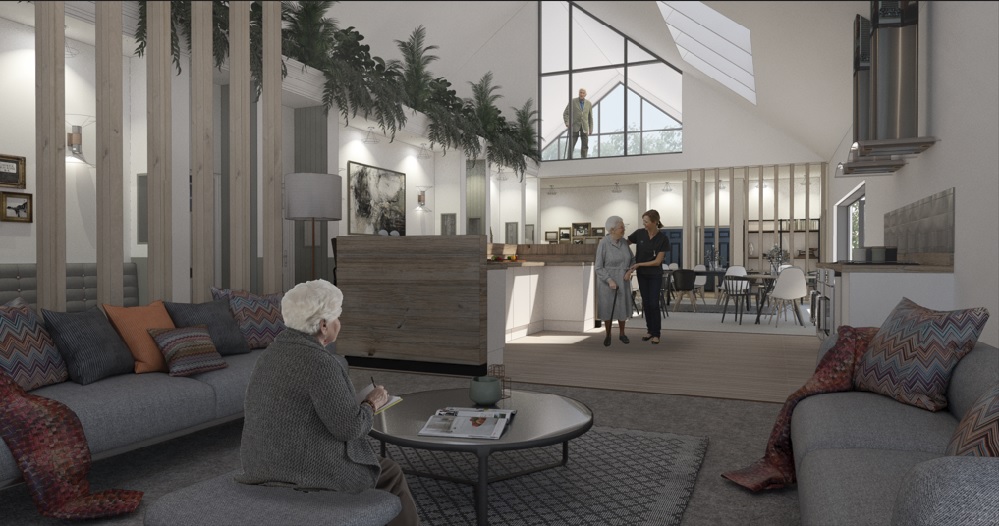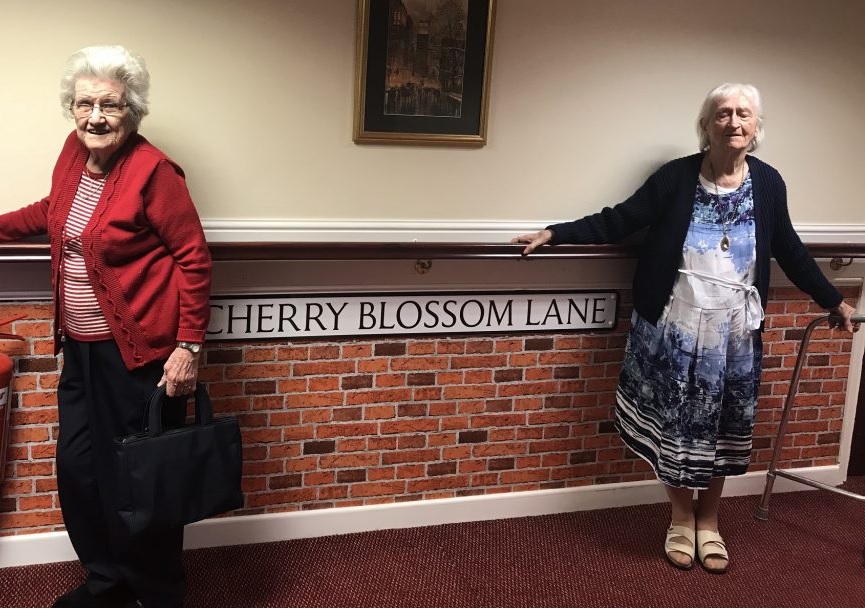
Credit: Abbeyfield Society.
Page contents
Many new care homes are dementia-designed care homes, designed with dementia in mind to help provide a dementia-specific environment. This includes special lighting and colour schemes, sign posting and smaller areas for socialising.
Having a specially dementia-designed care home for someone living with the disease can be hugely beneficial as it means they will be living in an environment adapted to their needs.
Below are some suggestions of what to look for in a dementia care home for your loved one.
Why is interior design for dementia care homes important?
For people living with dementia, a good design aims to help residents feel relaxed and less stressed. It can also help them feel like they are living in an environment which reminds them of home.
Getting the design right can make a fundamental difference to the lives of people with dementia. It can improve life experiences and can increase life expectancy of those affected by dementia.
James Botterill from HSSP Architects is an expert who designs smaller, more accessible spaces for residents living with dementia which helps them transition into the care home and enhances their quality of life.
Gone are the days of designing care homes containing long sterile, white corridors, and “noisy communal living, entertainment, and dining areas,” says Mr Botterill.

Credit: HSSP Architects.
Built all on one level rather than two or three storeys, his dementia-friendly design is an arrangement of six pods which form small self-contained communities within a care facility. Each pod is designed to house no more than 10 residents. Their bedrooms look out onto a living/dining space, making the resident feel at home. The plan is also inclusive for those residents who are bedbound.
Mr Botterill says: “Even if they are in their room, they can look out into the space to see what is going on. So they will not feel as though they are missing out on anything.”
Sensory gardens
The single storey allows residents easy access to the sensory gardens. These are designed to stimulate residents’ senses, which can be very beneficial for people living with dementia.
Mr Botterill also ensures the laundry room is built in the pod and is visible to the residents. This gets the residents involved and gets them to want to help to fold the laundry away.
.“Traditionally, care homes usually tuck the laundry room away out of sight but here, we do a street scene. This gets the residents away from a hotel environment where everything is done for you. It allows them to experience that home from home environment,” he says.
Memory boxes
Memory boxes are filled with memorable objects to help spark meaningful conversation, retain a sense of identity or when in a corridor, remember which is their room. This is also particularly useful for staff in the care home to get to know the person.
It’s important the items included in your memory box are able to trigger a range of strong emotions. Items can include a photograph of them from their youth, or an object from a previous occupation or hobby, a bottle of their favourite perfume or a bar of their favourite chocolate.
Using different colours is best for the interior of a care home
Some people living with dementia can have problems remembering where their room is in a care home. If all the bedroom doors look the same, the corridors lack obvious landmarks and use inadequate lighting. This can leave them extremely anxious and stressed.

Credit: Simonsfield Care Home
Dividing corridors up with distinctive colours by painting the doors and skirting boards helps keep people on the right path. It also confirms which department or area of the building they are in.
The corridors can be decorated with plenty of imagination.
Some care homes have been known to paint bedroom doors different colours, have window boxes on windowsills, and display advertisement posters and street names all to help their residents.
For example, if you know you lived on Penny Lane next to a 1950s Bovril advert and your room had a red door, this would give the person living with dementia confidence and the independence to find their room with ease.
Care homes should also have good lighting. This can help a person with dementia find their way around more easily.
Flooring and walls
Dementia affects how the brain interprets the information it receives and over stimulates the senses. Therefore, it is important that the care home chooses the right colours and patterns for flooring and walls.
Avoid any flecked, striped or patterned carpets. These can cause confusion for somebody living with dementia and can even cause hallucinations.
Care homes also try to avoid rugs and mats. This is because some people living with dementia may become confused and think the rug or mat is an object in the way. If it is a dark colour, they may think it is a hole in the floor where they may try and step over it causing them to trip and fall.
Light switches and grab rails in the showers and toilets should be different colours to the walls. This will make them easier to see.
It is also good if a contrasting coloured toilet seat is fitted so it reminds the resident of the purpose of using the toilet. This can help reduce confusion and lowers the chance of accidents.
Signs
Care homes often use signs on cupboards and doors so the residents living with dementia can navigate around easily.
For example, a sign on the toilet door is ideal for directing residents to where the toilet is located. This sign helps in offering the right direction and reduces confusion.
Care homes will also put pictures up on cupboard doors to show the residents what is inside them. For example, in the kitchen, there could be a photo of cups on the cupboard that contain these.
Mirrors
For people living with dementia, there can be a range of triggers that cause anguish or agitation, particularly as they become sensitive to their surroundings. For many, this can include mirrors.

Some residents may not recognise their own reflection while others may become frustrated that the person in the mirror does not respond or copy their actions.
They can also be scared there is a stranger in their room or embarrassed that they have to undress in front of someone.
While mirrors can cause upset for some, they can also offer comfort and companionship for others as people can form friendships with their reflection.
With this in mind, care homes can be designed without the use of mirrors in the bedrooms, bathrooms and communal areas to restore the residents’ sense of peace and contentment.
Eating
Simple tasks such as eating can be another problem for people with dementia. Cutlery can become more difficult to use as the person with dementia loses their coordination skills.
Care homes can purchase adapted cutlery and plate guards which will reduce spillages. Finger food is another option.
Guidance from Coventry and Warwickshire University Hospitals recommends using contrasting coloured plates. This can help to make food easier to see on the plate.
Pastel colours are difficult to recognise. So try to use primary colours (red, yellow and blue) which are recognised for longer by people as their dementia progresses.
Care homes should also avoid distracting items such as patterned tablecloths, vases or lots of condiments.
Find your ideal care home
- Explore a wide range of care options and facilities
- Read independent ratings and reviews
- Connect directly with care homes to book a tour and discuss your needs


